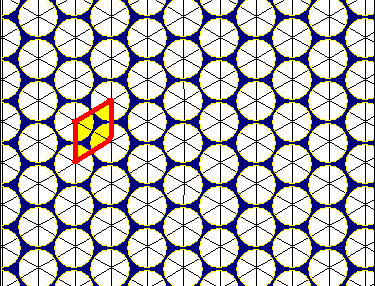Honeycomb conjecture on:
[Wikipedia]
[Google]
[Amazon]

 The honeycomb conjecture states that a regular
The honeycomb conjecture states that a regular
 The honeycomb conjecture states that a regular
The honeycomb conjecture states that a regular hexagonal grid
In geometry, the hexagonal tiling or hexagonal tessellation is a regular tiling of the Euclidean plane, in which exactly three hexagons meet at each vertex. It has Schläfli symbol of or (as a truncated triangular tiling).
English mathematic ...
or honeycomb
A honeycomb is a mass of Triangular prismatic honeycomb#Hexagonal prismatic honeycomb, hexagonal prismatic Beeswax, wax cells built by honey bees in their beehive, nests to contain their larvae and stores of honey and pollen.
beekeeping, Beekee ...
has the least total perimeter
A perimeter is a closed path that encompasses, surrounds, or outlines either a two dimensional shape or a one-dimensional length. The perimeter of a circle or an ellipse is called its circumference.
Calculating the perimeter has several pract ...
of any subdivision of the plane into regions of equal area. The conjecture was proven in 1999 by mathematician Thomas C. Hales
Thomas Callister Hales (born June 4, 1958) is an American mathematician working in the areas of representation theory, discrete geometry, and formal verification. In representation theory he is known for his work on the Langlands program and the p ...
.
Theorem
Let be any system of smooth curves in , subdividing the plane into regions (connected components of the complement of ) all of which are bounded and have unit area. Then, averaged over large disks in the plane, the average length of per unit area is at least as large as for the hexagon tiling. The theorem applies even if the complement of has additional components that are unbounded or whose area is not one; allowing these additional components cannot shorten . Formally, let denote the disk of radius centered at the origin, let denote the total length of , and let denote the total area of covered by bounded unit-area components. (If these are the only components, then .) Then the theorem states that The value on the right hand side of the inequality is the limiting length per unit area of the hexagonal tiling.History
The first record of the conjecture dates back to 36 BC, fromMarcus Terentius Varro
Marcus Terentius Varro (; 116–27 BC) was a Roman polymath and a prolific author. He is regarded as ancient Rome's greatest scholar, and was described by Petrarch as "the third great light of Rome" (after Vergil and Cicero). He is sometimes calle ...
, but is often attributed to Pappus of Alexandria
Pappus of Alexandria (; grc-gre, Πάππος ὁ Ἀλεξανδρεύς; AD) was one of the last great Greek mathematicians of antiquity known for his ''Synagoge'' (Συναγωγή) or ''Collection'' (), and for Pappus's hexagon theorem i ...
().
In the 17th century, Jan Brożek
Jan Brożek (''Ioannes Broscius'', ''Joannes Broscius'' or ''Johannes Broscius''; 1 November 1585 – 21 November 1652) was a Polish polymath: a mathematician, astronomer, physician, poet, writer, musician and rector of the Kraków Academy.
Life ...
used a similar theorem to argue why bees create hexagonal
In geometry, a hexagon (from Greek , , meaning "six", and , , meaning "corner, angle") is a six-sided polygon. The total of the internal angles of any simple (non-self-intersecting) hexagon is 720°.
Regular hexagon
A '' regular hexagon'' has ...
honeycomb
A honeycomb is a mass of Triangular prismatic honeycomb#Hexagonal prismatic honeycomb, hexagonal prismatic Beeswax, wax cells built by honey bees in their beehive, nests to contain their larvae and stores of honey and pollen.
beekeeping, Beekee ...
s. In 1943, László Fejes Tóth
László Fejes Tóth ( hu, Fejes Tóth László, 12 March 1915 – 17 March 2005) was a Hungarian mathematician who specialized in geometry. He proved that a lattice pattern is the most efficient way to pack centrally symmetric convex sets on th ...
published a proof for a special case of the conjecture, in which each cell is required to be a convex polygon
In geometry, a convex polygon is a polygon that is the boundary of a convex set. This means that the line segment between two points of the polygon is contained in the union of the interior and the boundary of the polygon. In particular, it is a ...
. The full conjecture was proven in 1999 by mathematician Thomas C. Hales
Thomas Callister Hales (born June 4, 1958) is an American mathematician working in the areas of representation theory, discrete geometry, and formal verification. In representation theory he is known for his work on the Langlands program and the p ...
, who mentions in his work that there is reason to believe that the conjecture may have been present in the minds of mathematicians before Varro.
It is also related to the densest circle packing
In geometry, circle packing is the study of the arrangement of circles (of equal or varying sizes) on a given surface such that no overlapping occurs and so that no circle can be enlarged without creating an overlap. The associated '' packing de ...
of the plane, in which every circle is tangent to six other circles, which fill just over 90% of the area of the plane.
See also
*Weaire–Phelan structure
In geometry, the Weaire–Phelan structure is a three-dimensional structure representing an idealised foam of equal-sized bubbles, with two different shapes. In 1993, Denis Weaire and Robert Phelan found that this structure was a better solution ...
, a counter-example to the ''Kelvin
The kelvin, symbol K, is the primary unit of temperature in the International System of Units (SI), used alongside its prefixed forms and the degree Celsius. It is named after the Belfast-born and University of Glasgow-based engineer and phys ...
conjecture'' on the solution of the similar problem in 3D.
References
Discrete geometry Euclidean plane geometry Conjectures that have been proved {{geometry-stub